

Japan - VALUES AND BELIEFS. Japan Table of Contents Contemporary Japan is a secular society.
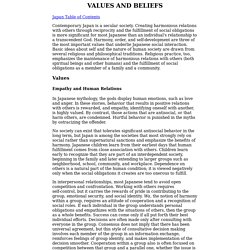
Creating harmonious relations with others through reciprocity and the fulfillment of social obligations is more significant for most Japanese than an individual's relationship to a transcendent God. Japan - Japan since 1945. Occupation From 1945 to 1952 Japan was under Allied military occupation, headed by the Supreme Commander for Allied Powers (SCAP), a position held by U.S.

General Douglas MacArthur until 1951. Although nominally directed by a multinational Far Eastern Commission in Washington, D.C., and an Allied Council in Tokyo—which included the United States, the Soviet Union, China, and the Commonwealth countries—the occupation was almost entirely an American affair. While MacArthur developed a large General Headquarters in Tokyo to carry out occupation policy, supported by local “military government” teams, Japan, unlike Germany, was not governed directly by foreign troops. Western culture and the end of Japanese 'harmony' Japan grew up with wa (harmony).
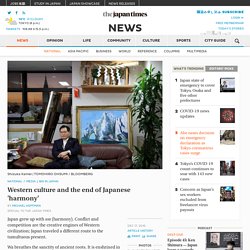
Conflict and competition are the creative engines of Western civilization; Japan traveled a different route to the tumultuous present. Wa breathes the sanctity of ancient roots. It is enshrined in a “constitution” dating back to A.D. 604, attributed to Prince Shotoku Taishi, who decreed: “Wa should be valued and quarrels avoided … .
When Cultures Collide. What prompted Japan's aggression before and during World War II? This question originally appeared on Quora.
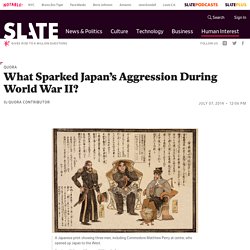
Answer by Harold Kingsberg: The short version: Japan’s actions from 1852 to 1945 were motivated by a deep desire to avoid the fate of 19th-century China and to become a great power. Religion in Japan. Shinto and Buddhism are Japan's two major religions.

Shinto is as old as the Japanese culture, while Buddhism was imported from the mainland in the 6th century. Since then, the two religions have been co-existing relatively harmoniously and have even complemented each other to a certain degree. Most Japanese consider themselves Buddhist, Shintoist or both. Religion does not play a big role in the everyday life of most Japanese people today. The average person typically follows the religious rituals at ceremonies like birth, weddings and funerals, may visit a shrine or temple on New Year and participates at local festivals (matsuri), most of which have a religious background. Religions and Philosophies Other Religion Related Pages. Western culture and the end of Japanese 'harmony'
Japan grew up with wa (harmony).
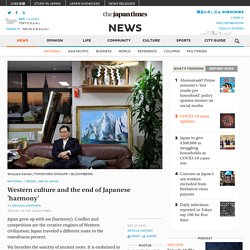
Conflict and competition are the creative engines of Western civilization; Japan traveled a different route to the tumultuous present. Wa breathes the sanctity of ancient roots. It is enshrined in a “constitution” dating back to A.D. 604, attributed to Prince Shotoku Taishi, who decreed: “Wa should be valued and quarrels avoided … .
Western Influences. Japanese Culture - Core Concepts. Portal Site of Official Statistics of Japan. Japan - VALUES AND BELIEFS. Cultural Values of Japan. Japanese values are thoroughly rooted in all aspects of life, and will always impact family, work, and social interactions.
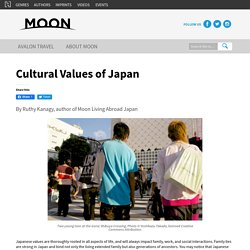
Family ties are strong in Japan and bind not only the living extended family but also generations of ancestors. You may notice that Japanese are not physically demonstrative in public and you won’t see any kissing and hugging on the streets. You do see friends and parents and children holding hands. One of the ways families express warmth and affection is to snuggle around the kotatsu (heated table covered with a comforter) in the winter, eating mikan (mandarin oranges) and watching TV. Another way is to scrub each other’s backs in the family bath. You will find that most people are very honest. Japan - Japanese expansionism.
After the conclusion of the war, Japanese leaders gained a free hand in Korea.

Korean opposition to Japanese “reforms” was no longer tolerated. Itō Hirobumi, sent to Korea as resident general, forced through treaties that gave Korea little more than protectorate status and ordered the abdication of the Korean king. Itō’s assassination in 1909 led to Korea’s annexation by Japan the following year. Korean liberties and resistance were crushed. By 1912, when the Meiji emperor died, Japan had not only achieved equality with the West but also had become the strongest imperialist power in East Asia. Japan had abundant opportunity to use its new power in the years that followed. Japan - VALUES AND BELIEFS. Comparing Modern Japan: Are There More Comparisons to Make?: Japanstudien: Vol 14, No 1. Comparison with other societies is such an ingrained part of the study of Japan that there is reason to ask whether in the future that habit will die out, continue as before, or take new directions.
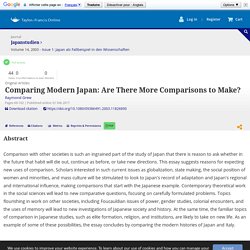
This essay suggests reasons for expecting new uses of comparison. Scholars interested in such current issues as globalization, state making, the social position of women and minorities, and mass culture will be stimulated to look to Japan's record of adaptation and Japan's regional and international influence, making comparisons that start with the Japanese example. Contemporary theoretical work in the social sciences will lead to new comparative questions, focusing on carefully formulated problems. Religion - Japanese Culture. Religion in Japan is a wonderful mish-mash of ideas from Shintoism and Buddhism.
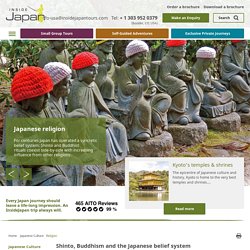
Unlike in the West, religion in Japan is rarely preached, nor is it a doctrine. Instead it is a moral code, a way of living, almost indistinguishable from Japanese social and cultural values. Japanese religion is also a private, family affair. It is separate from the state; there are no religious prayers or symbols in a school graduation ceremony, for example. Religion is rarely discussed in every day life and the majority of Japanese do not worship regularly or claim to be religious. However, most people turn to religious rituals in birth, marriage and death and take part in spiritual matsuri (or festivals) throughout the year.
Marketing ‘Japan’: Japanese cultural presence under a global gaze: Japanese Studies: Vol 18, No 2. Primary Sources with Document-based Questions. Millard Fillmore, 1800-1874; Matthew Perry, 1794-1858 • Commodore Perry and Japan (1853-1854) On July 8, 1853, Commodore Matthew Perry of the United States Navy, commanding a squadron of two steamers and two sailing vessels, sailed into Tôkyô harbor aboard the frigate Susquehanna and forced Japan to enter into trade with the United States. This unit examines that historical exchange with an introductory essay and an examination of the three letters that President Fillmore and Commodore Perry wrote to the Japanese emperor [PDF]. • Excerpts from the Letter from Emperor Meiji (Mutsuhito) to President Ulysses S. Japan. JapaneseSYNONYMS: Nihonjin, Nipponjin OrientationIdentification and Location. Propaganda of Japan and the U.S. During WW II. United States Japan ConclusionsA Critical Comparison Between Japanese and AmericanPropaganda during World War II.Anthony V.
Navarro Hakko Ichiu. (“Eight corner of the World under one roof.”) Japanese War Slogan Hostilities exist. JAPAN BEFORE WORLD WAR II: THE RISE OF JAPANESE MILITARISM AND NATIONALISM. Views of Japan in the West David Powers of the BBC wrote: “When Japan began its military adventures in China in 1931, it was a society in turmoil. Less than 80 years previously, it had been forced out of two-and-a-half centuries of self-imposed seclusion from the rest of the world, when the Tokugawa Shogunate was overthrown, and Japan embarked on rapid modernisation under Emperor Meiji.
[Source: David Powers, BBC, February 17, 2011 ***] “By the beginning of the 20th century, Japan was beginning to catch up with the world's great powers, and even enjoyed its own version of the Roaring Twenties, a period known rather more prosaically as Taisho Democracy. Imperial Japan saw itself as a 'warrior nation' – and the idea lingers today. In a warning to China on the eve of his first trip to Asia in November 2017, the US president, Donald Trump, called Japan a “warrior nation” that needed to be taken seriously. Trump’s comments are just one example of the widespread view that Japan is a martial country with spiritual roots in the samurai warriors of old. But is it?